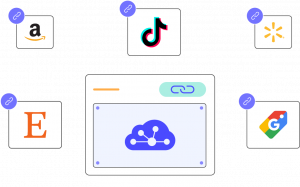With the ever-increasing importance of online shopping, it’s become essential for businesses to have a reliable and user-friendly eCommerce website. Creating a website can be a daunting task, but with a Shopify website builder, it’s easier than ever. Whether you’re looking to start an e-commerce store or redesign an existing one, the Shopify store builder offers an intuitive platform for merchants at any stage of their journey.
In this blog post, we’ll delve deeper into the features and benefits of using the Shopify website builder to build your online store. We’ll cover everything you need to know to build a website on Shopify, from initial setup to advanced customization, ensuring your business thrives online.
Just Starting Your Shopify Store? Let BulkFlow Help!
BulkFlow makes product listing faster by letting you import items in bulk from CSV, Excel, or Google Sheets. No need to add products one by one.
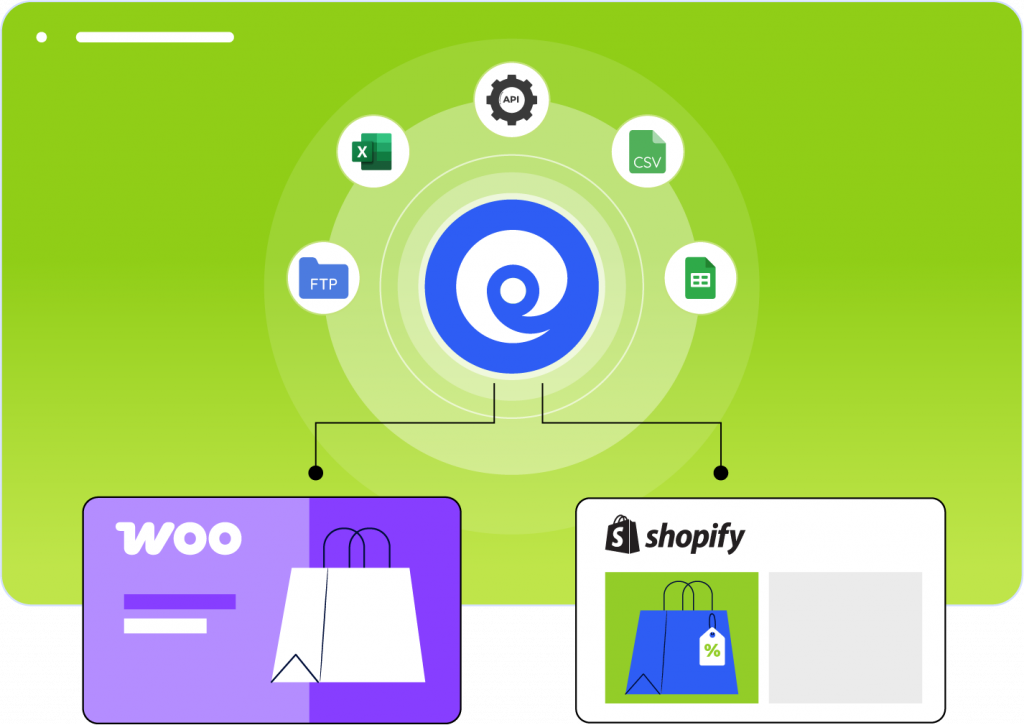
Introduction To Shopify Website Builder

With the Shopify website builder, you don’t need to be a coding expert to create a store that meets your business needs. From customizable templates to integrated payment gateways and marketing tools, Shopify simplifies the process of building and running an online store.
What is Shopify Website Builder?
The Shopify website builder is a powerful, user-friendly tool designed to help you create a functional and professional e-commerce store. Whether you’re an entrepreneur launching your first store or an experienced business owner looking to expand into the digital space, Shopify provides the comprehensive features you need to establish a successful online presence. It makes setting up a Shopify store straightforward for everyone.
Which website should use Shopify?
If you’re unsure what to sell, don’t worry! Shopify is an incredibly flexible platform that lets you create countless types of websites for nearly any industry. While it’s not limited to specific niches, the majority of stores on Shopify typically come from the following industries:
- Fashion and accessories
- Cosmetics and jewelry
- Houseware
- Electronic devices
- Food and drink
We want to reiterate that Shopify isn’t limited to any specific industry. The examples above are just the most popular ones. So, feel free to choose any business that aligns with Shopify’s terms and conditions.
Benefits of Building a Website on Shopify
If you’re considering launching an online store, choosing the right platform is crucial. Shopify stands out as one of the best solutions on the market for several reasons, making it the preferred choice for over 1 million businesses worldwide. Learning to build a website on Shopify offers distinct advantages.
Ease of Use
Shopify is designed with simplicity in mind, allowing users of all technical backgrounds to create and manage their stores. Shopify’s intuitive drag-and-drop interface ensures that you can quickly set up your online store without needing advanced coding skills. This truly simplifies how to build a website on Shopify.
Scalability
Shopify is perfect for businesses of all sizes. Whether you’re starting small or planning to scale into a global brand, the Shopify store builder grows with your business. With access to advanced tools like Shopify Plus, which is designed for enterprise-level stores, merchants can upgrade their plans as their needs evolve.
Comprehensive Tools
One of the biggest advantages of the Shopify store creator is its comprehensive set of built-in features. From SEO optimization tools to integrated payment gateways, Shopify provides everything you need to run your business efficiently.
How to Build a Website on Shopify: Step-by-Step Guide
Ready to dive into e-commerce? This Shopify website setup tutorial makes building your online store straightforward, even without any coding experience. Just follow these steps to get your business up and running:
Step 1: Define the Purpose of Your Online Business
Before you even touch the website builder, the very first step is to clarify your business’s core purpose and vision. This strategic thinking will guide all your subsequent design Shopify website and operational decisions.
- What kind of products or services are you planning to sell? Be specific about your offerings.
- Who is your target clientele? Understanding your audience helps tailor your marketing and store design.
- What is your business niche? Identify what makes your business unique in the market.
- What are your business goals? Are you aiming for sales volume, brand recognition, or something else?
- What value are your customers receiving from your products and services? Highlight the benefits you provide
By determining answers to these critical questions, you will be able to create a clear roadmap of the features and design elements needed to accomplish your goal. It’s also a good idea to check out what your possible competitors are doing and what you would like to offer your customers differently.
Once you have a clear plan, then you can move on to creating your online store with the help of the Shopify store builder.
Step 2: Create Your Shopify Account
Begin your journey by signing up for a Shopify free trial. This is your gateway to the platform and allows you to explore its features without immediate commitment.
- Visit the Shopify website and click on “Start free trial.“

- Provide your email address, create a password, and choose a store name.

- Answer a few quick questions about your business to help Shopify tailor your experience. Once completed, your new Shopify admin dashboard will be ready.
Step 3: Add Products to Your Store
With your account set up, the next crucial step is to populate your store with products.
- From your Shopify admin, navigate to “Products” and click “Add product.”
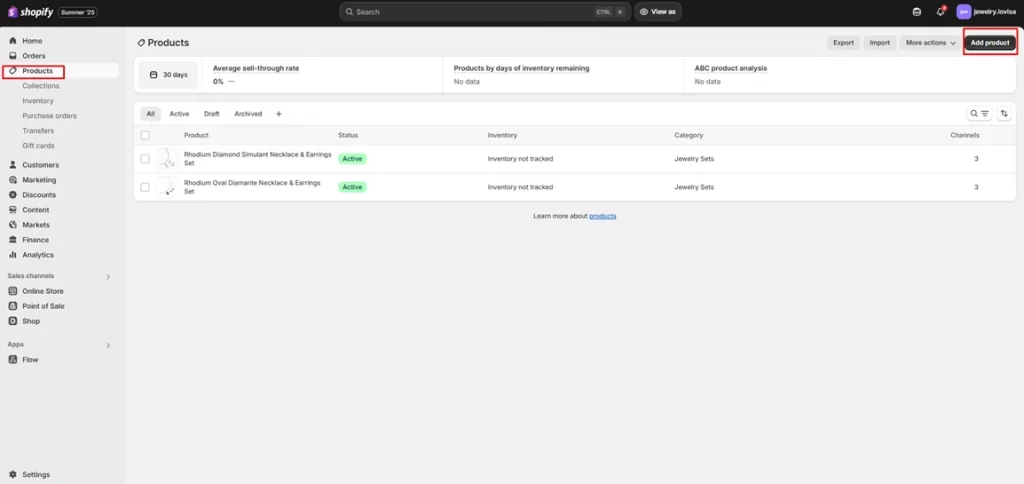
- Enter Product Details: Provide a compelling product title and a detailed description that highlights its features and benefits.
- Upload Media: Add high-quality images and videos of your product from various angles.
- Set Pricing: Define the price of your product, compare-at price (for sales), and cost per item.
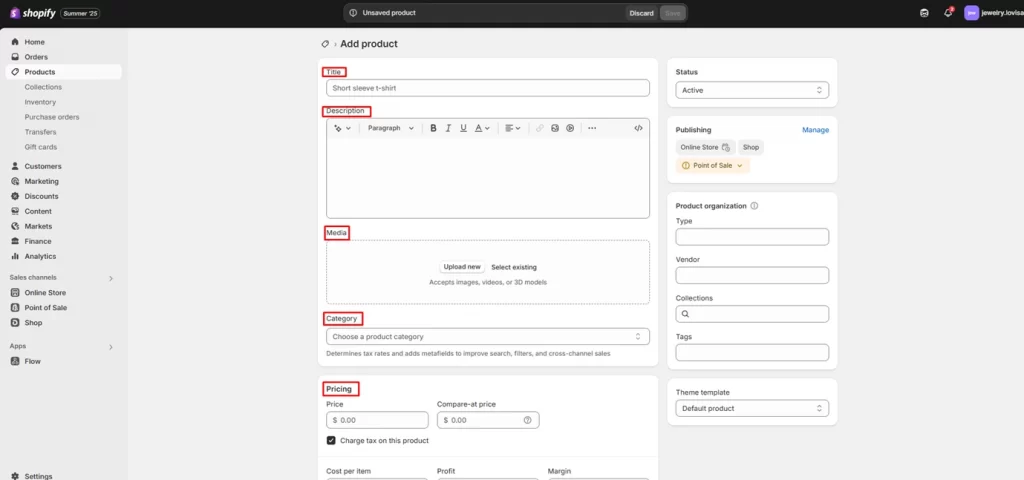
- Manage Inventory: Input the quantity of products available and set up inventory tracking.
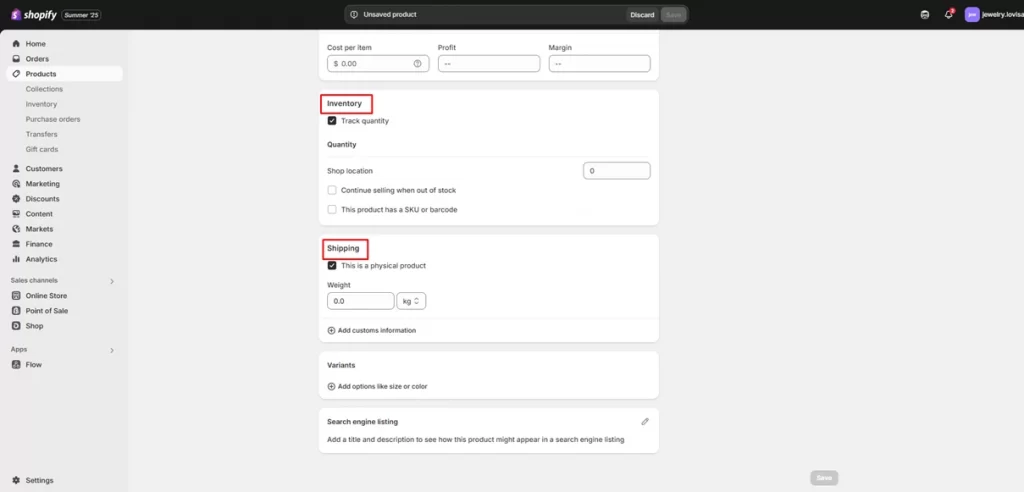
- Add Variants: If your product comes in different sizes, colors, or materials, create variants.
- Shipping: Set up weight and customs information if applicable.
- Organization: Assign your product to collections and tags for better organization and customer navigation.
Speed up product uploads to Shopify with CSV
LitCommerce lets you quickly add or update products with smart attribute mapping and advanced filter, for accurate, hassle-free data management.
Step 4: Design and Customize Your Store’s Appearance
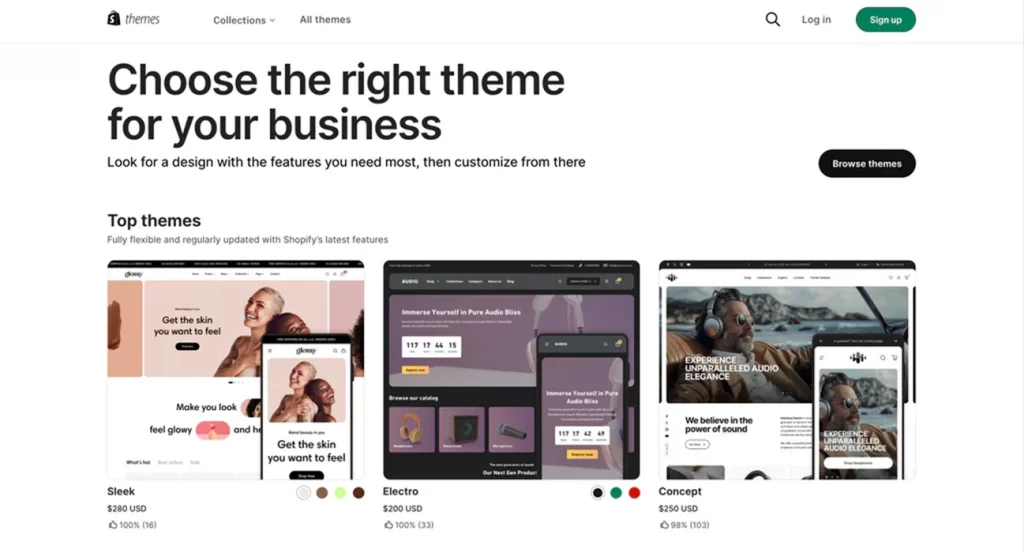
This is where you bring your brand to life and make your store visually appealing.
- Choose a Theme: Go to “Online Store” > “Themes.” You can select from Shopify’s extensive library of free and paid themes. Choose one that aligns with your brand’s aesthetic and industry.
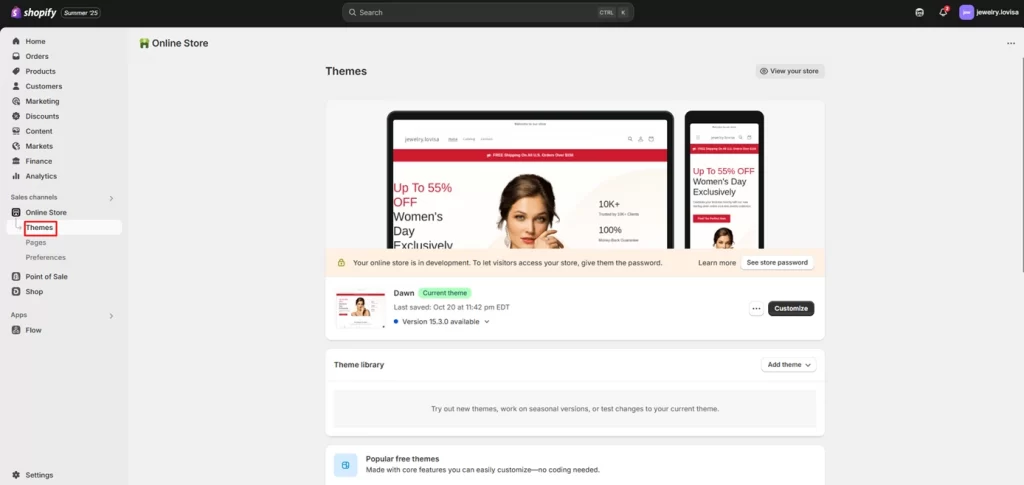
- Customize Your Theme: Click “Customize” next to your chosen theme to open the theme editor.
- Sections: Use the drag-and-drop sections to add or remove elements like image banners, product grids, text blocks, testimonials, and more to your homepage and other pages.
- Theme Settings: Adjust global settings such as colors, typography, layout, social media links, and checkout settings to ensure brand consistency.
- Blocks: Within sections, you can often add individual blocks (e.g., text, image, button) to further refine your layout.
- Add Essential Pages: Create standard pages like “About Us,” “Contact Us,” “Privacy Policy,” “Refund Policy,” and “Terms of Service” by going to “Online Store” > “Pages.”
- Set Up Navigation: Organize your store’s menus (main menu, footer menu) under “Online Store” > “Navigation” to ensure customers can easily find what they’re looking for.
While Shopify provides a selection of basic themes for foundational pages, to achieve deeper customization and unlock more advanced features, we suggest using a drag & drop page builder app like GemPages – Shopify Page Builder. You’ll find a detailed guide on this in the next section: Customize your website functionality with GemPages.
Step 5: Configure Shipping Settings
Efficient shipping is key to customer satisfaction.
- Navigate to “Settings” > “Shipping and delivery” in your admin.

- Set Up Shipping Zones: Define geographical zones where you will ship products (e.g., domestic, international regions).
- Create Shipping Rates: For each zone, set up shipping rates based on price, weight, or flat rates. You can also offer free shipping or calculated rates from carriers.
- Package Dimensions: Input your default package dimensions for accurate carrier calculations.
Step 6: Set Up Payment Gateways
Enable customers to pay for their orders securely.
- Go to “Settings” > “Payments.”
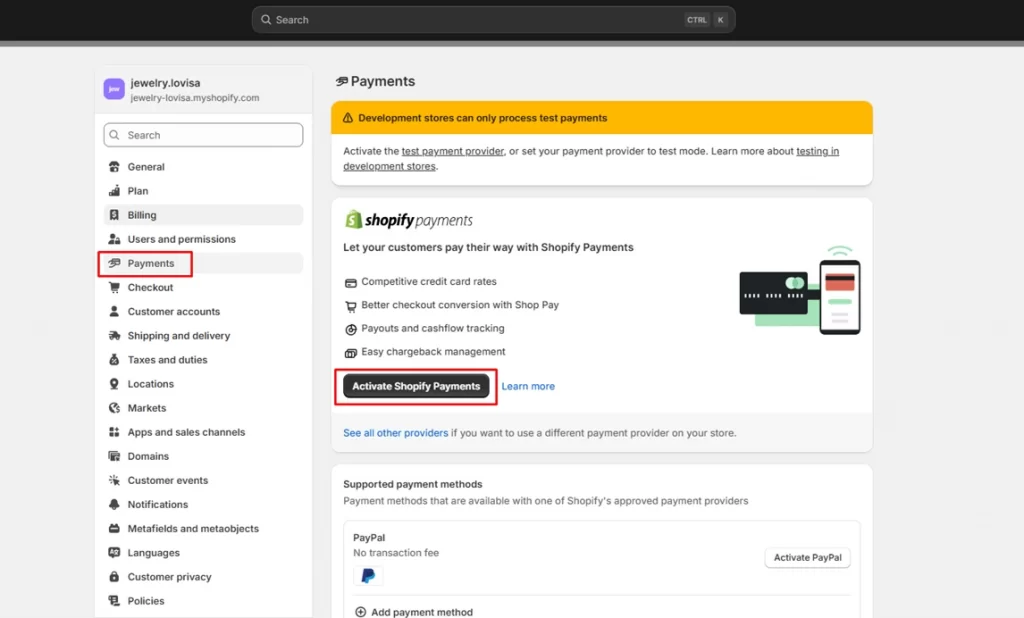
- Activate Shopify Payments: This is Shopify’s integrated payment gateway, offering competitive rates and ease of use. It allows you to accept major credit cards directly.
- Add Other Payment Providers: You can also integrate third-party payment gateways like PayPal, Stripe, or others relevant to your region.
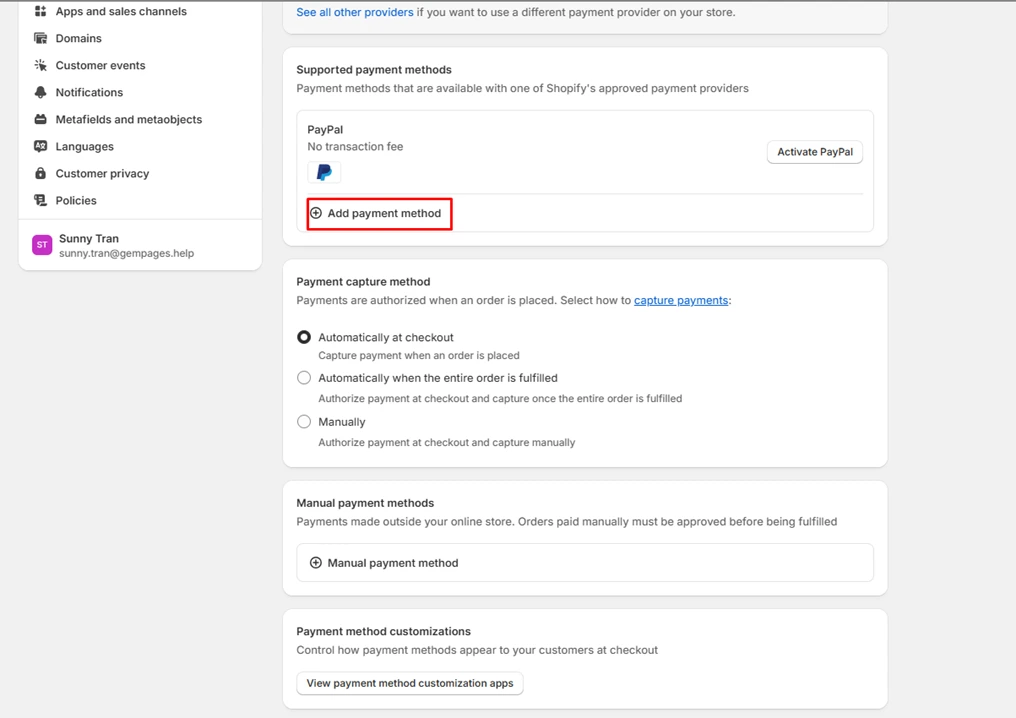
- Manual Payment Methods: Offer options like bank deposits or cash on delivery if appropriate for your business model.
Step 7: Launch Your Shopify Store
Once you’ve added products, designed your store, and configured your settings, you’re ready to go live!
- Review All Settings: Double-check all your product details, prices, shipping rates, payment settings, and legal pages to ensure everything is accurate and complete.
- Remove Password Protection: By default, your new Shopify store will have a password page. To make your store visible to the public, go to “Online Store” > “Preferences” and uncheck “Enable password page.”
- Add a Custom Domain: For a professional look, connect a custom domain name (e.g., yourstorename.com). You can purchase a new domain through Shopify or connect an existing one.
By following these steps, you’ll be well on your way to launching a fully functional and professional online store with the powerful Shopify website builder.
Key Features of Shopify Website Development
Whether you’re a budding entrepreneur or an established business owner, starting an online store can seem a bit challenging at first. This is because most website creators come with a certain learning curve, which can make a platform less user-friendly for beginners. However, that’s not the case with Shopify.
Let’s explore some of the most impactful features that Shopify website development offers (the best of many) and how they can help you as a future Shopify store owner.
Shopify POS

In today’s ever-changing retail landscape, businesses must adapt quickly to remain competitive. One of the best ways to do that is by utilizing Shopify POS. This point-of-sale system is a powerful and flexible solution for businesses looking to sell in person. With its comprehensive features and easy-to-use interface, Shopify POS is the perfect tool for streamlining your retail operations.
- You can sell almost anywhere, from brick-and-mortar stores to markets and pop-up shops.
- It syncs with Shopify to track orders and inventory across all sales channels, providing a unified view of your business.
- It has a fully customizable interface for a tailored point-of-sale system that fits your specific needs.
- Integrated hardware works seamlessly with Shopify card readers and compatible accessories for smooth transactions.
- Comes with advanced inventory management features, including generating purchase orders and transferring stock based on performance and demand.
Payment Gateway and Integrations
When it comes to running an online store, providing your customers with the right payment methods is crucial. It’s important to offer a range of options to ensure a seamless shopping experience. Shopify website development offers a variety of payment methods, from its own payment gateway to third-party providers, to ensure you can meet your customers’ needs. This includes:
- Shopify Payments: This eliminates the need for a third-party payment provider or merchant account and allows you to accept all major payment methods as soon as you create your store.
- PayPal: As one of Shopify’s default payment providers, PayPal allows payments through credit cards, bank accounts, buyer credit, or PayPal account balances. You’ll need to set up your PayPal account before collecting payments.
- Other Payment Providers: In addition to Shopify Payments and PayPal, Shopify offers integrations with over 100 other payment providers worldwide. This ensures you can choose the best payment gateway for your business and your customers, no matter where they are.
It’s important to choose a payment gateway that is available and commonly used in the countries your business operates in.
Abandoned Cart Recovery
In online retail, cart abandonment is a common phenomenon where customers add items to their shopping cart but leave the website before completing the purchase. With an average cart abandonment rate of 69.99% (source: Baymard Institute), taking the necessary steps to save your sales and revenue from dropping is imperative.
Shopify enables businesses to recover their abandoned checkouts and aid in recovering lost sales, which can significantly increase their conversion rates.
- With this particular feature from Shopify, you can easily identify customers who have added products to their cart but haven’t completed the purchase.
- The best part? You can send them a friendly email reminder that includes a direct link to their abandoned cart, giving them the opportunity to complete their checkout with just one click! This simple yet effective tool helps you reclaim potentially lost revenue.
SEO and Marketing Tools
Once your store is up and running, it’s time to focus on marketing and SEO to attract visitors and turn them into loyal customers. Fortunately, the Shopify store builder has got you covered with a range of powerful marketing and SEO features that will help you grow your business and increase sales.
- You can create marketing activities and automation directly from the Marketing section of Shopify and watch as your sales soar.
- You can also set up discount codes for customers to use in your online store or physical retail location, encouraging purchases.
- Shopify’s built-in SEO tools simplify optimizing your search engine ranking and help customers find your products more easily.
- Shopify lets you integrate Google Analytics into your store, providing valuable data so you can make better decisions about improving the customer experience on your site.
Customer Management Tools
Customer management is essential for any business, and Shopify makes it easy to interact with your customers effectively. The Shopify store builder comes with features that help you manage all your customer information, including their name and address, order history, and even group them according to similar characteristics to help you communicate with them more effectively.
- You can track your customers’ purchases and interests and send targeted offers based on their purchase history or profile information, leading to higher conversion rates.
- Organize your customers according to what they buy or how much they spend. This allows you to send targeted promotions to specific customer segments, which can significantly increase sales and improve customer retention.
- You can also send email messages to individual customers or groups of customers using customer segments directly from your admin.
All these features from Shopify are designed to enhance customer retention, boost sales, and ultimately drive a successful business.
Customize your website functionality with GemPages
While Shopify provides a selection of basic themes for foundational pages, to achieve deeper customization and unlock more advanced functionalities, we highly recommend using a drag & drop page builder app like GemPages – Shopify Page Builder. GemPages not only helps you create a unique Shopify website design but also optimizes the user experience and boosts conversion rates.
Here are the key features of GemPages that help you effectively customize your website functionality and build powerful sales funnels:
Tailor Your Homepage
Your homepage is the first thing visitors see when they land on your store. A well-designed homepage sets the tone for the entire shopping experience and can significantly impact conversion rates. If you build a website on Shopify, you can easily modify sections of your homepage to highlight best-selling products, showcase seasonal promotions, or share compelling customer reviews.
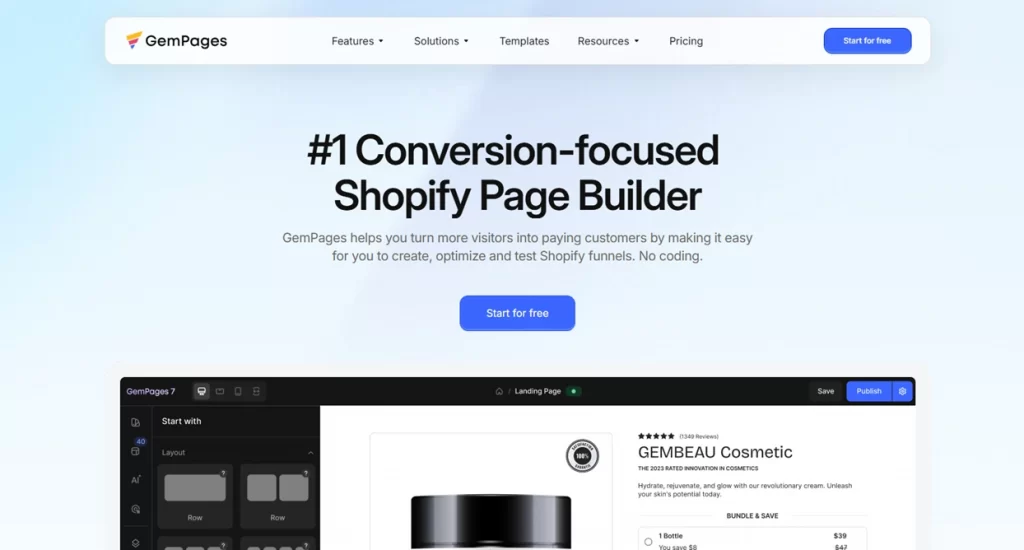
When creating a high-converting Shopify store homepage, it’s essential to focus on both design and functionality to capture your visitors’ attention immediately. Using a powerful drag-and-drop page builder like GemPages allows you to customize your homepage layout with incredible flexibility and no coding required, ensuring a seamless user experience.
Here is the steps you can to follow:
- Install GemPages: Begin by installing GemPages directly from the Shopify App Store or by searching for “GemPages” within your Shopify Admin Dashboard and following the installation prompts.
- Create a New Page: Once installed, navigate to the GemPages dashboard and select “Create New Page.”
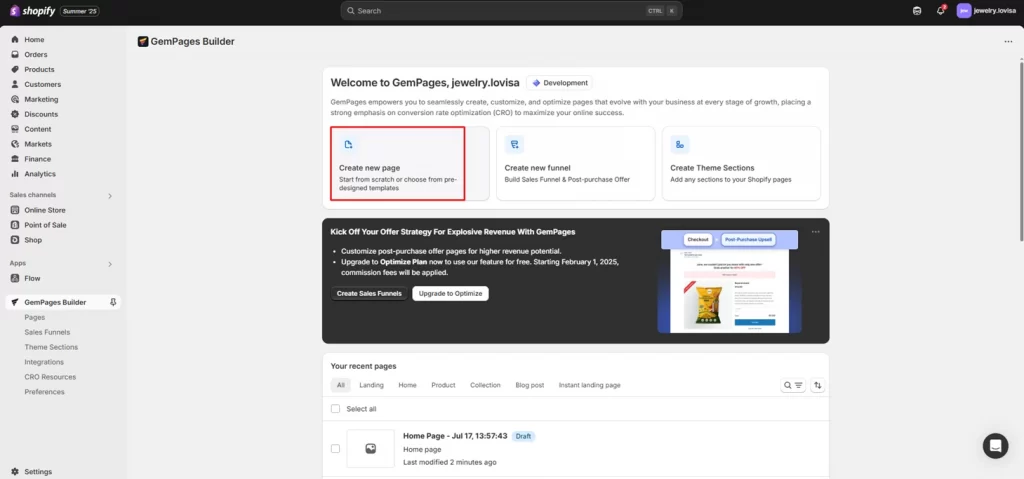
- Choose “Home Page” use case: From the options provided, select “Home Page” as your use case. This will give you a suitable starting point for your homepage design.
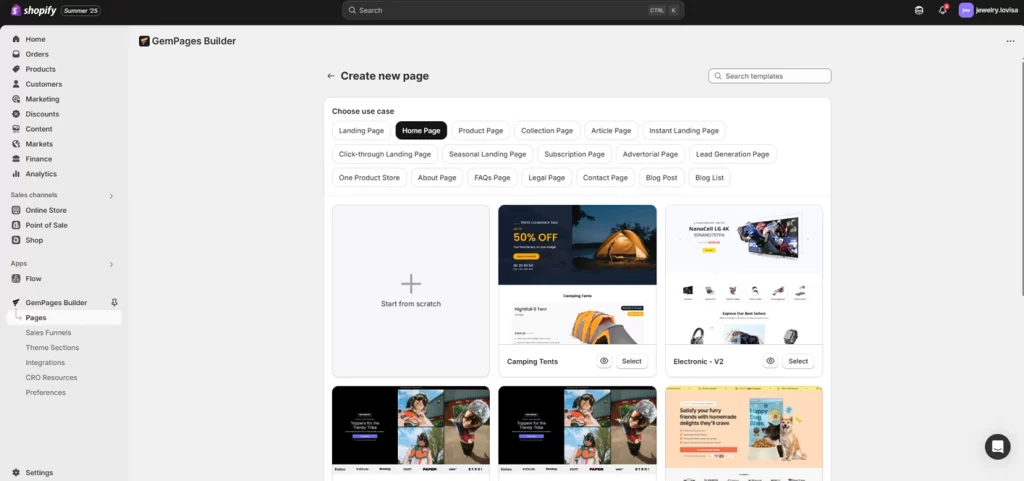
And now, the magic begins! You can drag and drop various elements – from banners and product grids to text blocks, testimonials, and contact forms – onto your page. Customize colors, fonts, spacing, and more to perfectly match your brand’s aesthetic.
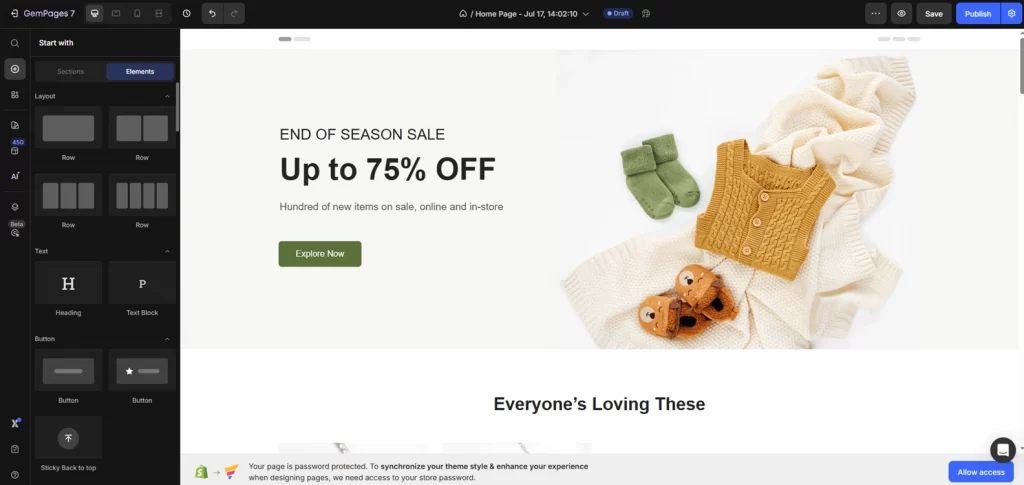
GemPages helps you optimize your Shopify store for better conversions, making it an ideal solution for merchants looking to craft a visually stunning and highly effective homepage design.
Custom Product Pages
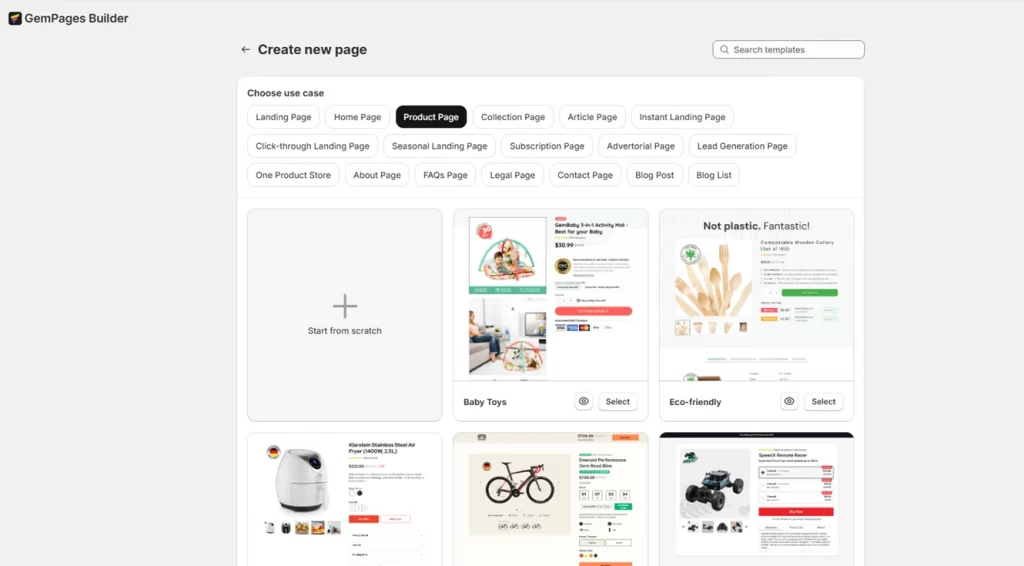
Product pages are where customers make buying decisions, so getting them right is crucial. GemPages allows you to go beyond the limitations of default themes to customize how product images are displayed, key information is presented, and reviews are integrated. You can add extra features like 360-degree product views or customer testimonials to enhance the Shopify website design experience and provide customers with all the information they need to make a purchase.
Navigation and User Experience
GemPages helps you create a clear and coherent navigation structure, ensuring customers can easily find what they’re looking for. Whether it’s a specific product category or your return policy, GemPages supports you in arranging your store’s layout logically to optimize the customer journey.
Edit Your Store’s Shopping Cart Page
The cart page is critical for conversions and reducing cart abandonment. With GemPages, you can customize the cart page to:
- Displaying product details clearly, such as quantity, size, and price.
- Offering options for shipping costs or delivery estimates upfront.
- Including trust signals (e.g., security badges or customer support information).
- Providing easy-to-edit product options, like adjusting quantities or removing items.
- Consider adding upsell or cross-sell suggestions based on what the customer has added to their cart to increase average order value.
Optimize the Checkout Page
While Shopify’s core checkout process is mostly fixed, optimizing the pre- and post-checkout elements is vital. GemPages helps you create seamless and intuitive pre-checkout pages that encourage customers to complete their transactions. Key optimization strategies include:
- Minimizing the number of steps to complete a purchase.
- Offering guest checkout for users who don’t want to create an account.
- Displaying clear shipping and payment options.
- Adding trust signals such as secure payment badges.
- Offering multiple payment methods to cater to different preferences, ensuring a smooth and successful transaction.
Additionally, you can leverage GemPages to:
- Build dedicated landing pages.
- Create post-purchase upsell offers.
- Perform A/B testing for your offers.
- Analyze conversions to continuously optimize your sales funnel.
Learn more about how GemPages can transform your store by checking out GemPages Tutorials: The Ultimate Guide For Beginners.
Post-launch Tips for Shopify Store Creators
You’ve launched your Shopify store – congratulations! Now, let’s make sure it not only runs smoothly but also attracts more visitors and boosts sales. Here are three key strategies to implement after your big debut:
Kickstart Sales with a Post-Launch Promotion
Get the ball rolling with an enticing offer. Consider running a special sale, offering a discount code, or even a free gift with purchase to encourage those crucial first orders. Don’t forget to shout about it! Leverage social media to create a buzz and send out email marketing campaigns to entice both new and returning customers.
Optimize Your Store for Search Engines
To get found online, search engine optimization (SEO) is your best friend. As a new Shopify store owner, prioritizing SEO is crucial for ranking higher in search results. Continuously optimize your website’s content, product descriptions, and metadata with relevant keywords. To further boost your store’s authority, look into building quality backlinks and guest posting on relevant blogs.
Harness the Power of Customer Feedback
Your customers are a goldmine of insights. Actively gather their feedback to enhance your store’s user experience. Simple surveys or dedicated customer feedback tools can help you collect valuable suggestions. Use this information to fine-tune your website, refine your product offerings, and elevate your customer service, creating a better experience for everyone.
FAQS
Do I need coding skills to build a website on Shopify?
No, absolutely not. Shopify is designed with a user-friendly Shopify website builder interface, including drag-and-drop functionality, that allows you to create and manage your store without any prior coding experience.
How long does it take to build a website on Shopify?
The time it takes can vary depending on your preparation and complexity, but with our step-by-step guide and Shopify’s intuitive tools, you can set up your online store and launch your Shopify website in a relatively short period, often within a few days or weeks for a basic store.
What types of businesses can use Shopify?
Shopify is an incredibly versatile platform suitable for nearly any industry. While popular with fashion, cosmetics, houseware, electronics, and food businesses, it’s not limited to specific niches and can accommodate a wide range of products and services.
Can I fully customize the design of my Shopify website?
Yes, Shopify offers extensive theme customization options. For even deeper control and advanced design functionalities without coding, we highly recommend using a powerful drag-and-drop page builder app like GemPages – Shopify Page Builder, which allows for incredible flexibility in design.
Conclusion
Building a successful online store might seem daunting at first, but by following the steps outlined in this guide, you’re well on your way to making your e-commerce dreams a reality. Remember, the journey doesn’t end at launch; continuous optimization and engaging with your customers are key to long-term growth.
With Shopify’s user-friendly platform and these strategies in hand, you have everything you need to build a website on Shopify that not only looks great but also thrives. Get ready to turn your vision into a flourishing.


